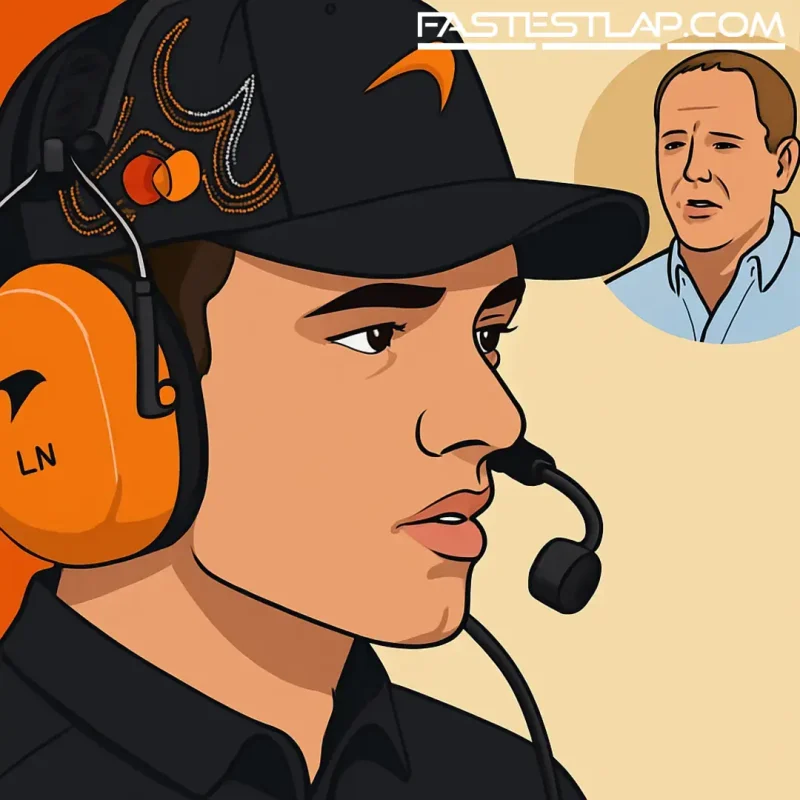Brundle tips “in-house” penalties for Norris — and warns McLaren’s harmony has a shelf life
Lando Norris says he’s facing “repercussions” at McLaren until the end of the season after that brush with Oscar Piastri on lap one in Singapore. What those repercussions actually are remains a state secret in Woking. Zak Brown is keeping the lid on it, calling the clash “pretty minor” and the consequence to match. But Martin Brundle has a fair idea how this game is played.
On Sky F1 duty, Brundle reckoned any sanction would live squarely inside the garage, not out on the pit wall where it could cost McLaren against Red Bull, Ferrari or anyone else. Think towing duties in qualifying. Think priority on new bits if there’s a development race. The kind of tiny advantages that can swing a Saturday, and a message that hits home without handing rivals a freebie.
It fits McLaren’s stance all season. The “papaya rules” were simple from day one: race hard, don’t hit each other. Singapore crossed that line — barely, but it did. So yes, the consequence is low-key. No public flogging, no team orders carved in stone. Just a couple of quiet nudges that say: you went too far; don’t do it again.
Brundle also made the point that, if the car on Norris’s outside hadn’t been an orange one, we’d have all been applauding the aggression. The opening corners were elbows-out and brilliantly judged… right up to the moment rims kissed rims. That’s the paradox of intra-team warfare: exactly the kind of racing you want, until your mechanics are sweeping carbon off the pit lane.
So what might Norris actually face? The hints are obvious:
– Qualifying tow priority for Piastri at tracks where the slipstream matters.
– First call on an upgrade package if the parts count is tight.
– The odd pit window preference or run plan that subtly stacks the deck.
None of that hurts McLaren relative to its rivals. All of it reminds a driver that the bill for a misstep sometimes arrives a few sessions later.
Of course, the real stress test isn’t the sanction — it’s the standings. Piastri is leading the title race and Norris trails his teammate by 22 points heading into the United States Grand Prix. That gap gives the dynamic a sharp edge. McLaren is still letting them race, but when a championship is in play, the tolerance for risk shrinks by the lap. And while Max Verstappen and Red Bull have found form in the RB21 of late, Woking’s clearest path to the big trophy is keeping both papayas in play, every Sunday.
Brundle didn’t sugar-coat the wider reality either. Two elite drivers, one title on the line, the same garage. “Doomed to fail” might be too fatalistic, but history’s littered with pairings that ran out of harmony before they ran out of speed. It’s not if the friction arrives — it’s how a team manages it when it does.
To McLaren’s credit, they saw this coming and set the guardrails months ago. Brown said there’s a matrix of consequences agreed with the drivers for different scenarios, and Singapore sits down near the bottom of that list. That’s why the penalty is light and largely private. But “private” doesn’t mean invisible. Watch qualifying run plans. Watch who gives whom the tow, and on which lap. Listen for the dry, carefully worded radio calls about swapping track position or “helping the other car.” Those are the breadcrumbs.
There’s also a human element here that gets lost in the spreadsheets. Norris and Piastri have worked extraordinarily well together for two drivers running at the front, their reputations rising in parallel. They’re quick, clean and, most days, smart. The tension comes when championships start asking for choices — and those choices start costing you on the other side of the garage.
If McLaren can carry this to the finish without pulling out the old-fashioned sledgehammer of team orders, they’ll have threaded a very fine needle. More likely, the closer we get to the final flyaways, the more those “minor” nudges turn into something firmer. Not because the team wants to — because the title fight will demand it.
For now, Norris’s penance looks set to be aerodynamic rather than existential. A tow here, a little patience there, and absolutely no more orange-on-orange contact. The rest? Settled at 320 km/h, on a Sunday afternoon, in front of the world.




